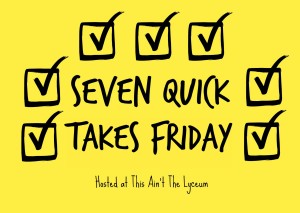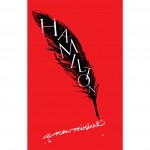This week, I had a lot of fun reading an observational study of the rituals we’ve built up around our interactions with technology–what they tell us about how we understand our relationship with our devices and what they portend for designs to come. I particularly enjoyed seeing one I frequently employ:
The Security Pass Hip Bump, which I first noticed a former client doing repeatedly in the library building she worked in, is particularly enjoyable. It occurs when someone carries their RFID-enabled security pass in their bag, and approaching a sensor, lifts the hip to angle the bag towards the sensor, creating a handsfree connection and activating the lock (the hands are often full of paper files, ironically enough.) It’s clearly an odd thing to do, when considered like this—to insouciantly cock your hips towards a small black rectangle on the wall as a form of greeting and personal identification—but can be carried off with a certain panache, admittedly.
I loved doing this in college, particularly at the one college gate that was placed a little too high for my hip, so I’d take a little run up, jump, and bonk it from the side. It was as close as I could licitly get to kicking down doors.
There’s something very fun about reading an observational study of everyday behaviors as though they were alien and previously unknown. In “The Moss Troll Problem” I saw another reason to appreciate the possibilities that the ordinary affords us.
“The advantage of writing urban fantasy or world-crossing fantasy is that when the sea serpent has eyes the color of NyQuil, you can say so rather than spending time trying to come up with settlement-era Icelandic-ish equivalent having something to do with moss-troll ichor. Because then you’re stuck with moss-trolls, and also they have ichor, and you can pretty well guarantee that’s going to come back and bite you in the butt in another book or two: you didn’t have to deal with moss-trolls *before*, and now you do, and it’s a lot of bother just for a color analogy.”
[…]
Now consider the Moss-Troll Problem and what it says about secondary-world fiction. We’ve declared one of the fundamental gestures of literature out of bounds. We make this same gesture–this thing is like this other thing–but we have denied ourselves the frame of reference in common with the reader. So when we do this, when we say the sea serpent’s eyes are the color of moss-troll ichor, we have to somehow convey both sides of the analogy, rather than relying on one half to explain the other. Secondary-world fiction therefore takes self-referentiality and makes it into a defining gesture of the genre, a form of intensely compressed poetry. This is the place where world-building is trying to get you, where you have a secondary world that’s rich enough and deep enough that it can generate its own frame of reference, that you can reinvent the wheel using unobtanium and dragons’ bones.
We can wind up in the position of fantasy writers, too, but it’s more likely to be when we need words for new concepts rather than new words for old concepts. I used to have fun imagining the Académie française carefully discussing what word will be the French equivalent of something invented by a foreign speaker.
ASL doesn’t have a central language regulator, so new signs are adopted through slow consensus. In the interregnum, as Hopes and Fears chronicles, variant signs emerge as the translations of ideas like “selfie” and “emoji”
New technology answers (and creates!) new needs. As newspaper technology has changed, one old need has diminished, and, with it, the prevalence of “bus plunge” stories. Slate has the story of how journalists scoured foreign news to find bus accidents that could plug short gaps at the end of articles in layout:
Not all bus plunges were judged equal by the foreign desk, according to Siegal. “It was better when buses plunged in countries with short names,” he says. “A bus plunge in Peru was infinitely easier to deal with than a bus plunge in Argentina or Paraguay.”
The Daily Mail has a story on a different kind of space filling, profiling a New York priest who filled his Serbian Orthodox church with icons.
Icons are not meant to look realistic, with portions painted out of scale or with symbolic flourishes. While the artists, mostly out of humility, don’t sign their work, it is often easily identifiable.
Jurewicz’s saints have light around their eyes, showing that the Holy Spirit is within them, and are topped by halos of light, representing God shining from behind. The Virgin Mary is always in a blue garment cloaked in red, and Christ always wears a red garment under a blue cloak.
‘The red is a sign of his divinity and the blue is our humanity. He clothed himself in our humanity. Mary clothed herself in divinity,’ Trbuhovich said.
Religious art opens a window on the transcendent for us. During the Cold War, a law professor wanted to find a way of giving the President a window on the too-high-to-imagine stakes of nuclear war:
My suggestion was quite simple: Put that needed code number in a little capsule and then implant that capsule right next to the heart of a volunteer. The volunteer would carry with him a big, heavy butcher knife as he accompanied the President. If ever the President wanted to fire nuclear weapons, the only way he could do so would be for him first, with his own hands, to kill one human being. The President says, “George, I’m sorry but tens of millions must die.” He has to look at someone and realize what death is–what an innocent death is. Blood on the White House carpet. It’s reality brought home.
When I suggested this to friends in the Pentagon they said, “My God, that’s terrible. Having to kill someone would distort the President’s judgment. He might never push the button.
Finally, if you want a preview of tomorrow’s radio show, I’ll be discussing (and recommending!) Rosamund Hodge’s Crimson Bound, and, if you want an early taste of how she fractures fairy tales, her Snow White-ish story “The Lamps Thereof are Fire and Flames” is up at Uncanny Magazine.
For more Quick Takes, visit Conversion Diary!













